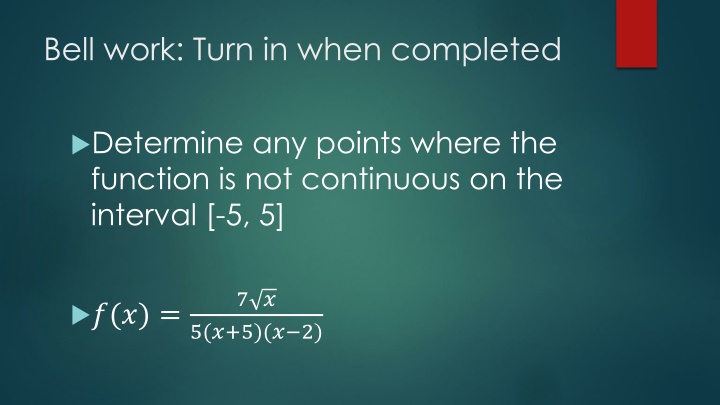
Identifying Points of Discontinuity in a Polynomial Function
Explore how to determine points of discontinuity in a polynomial function on a given interval. Discover roots of equations and understand the concept of polynomial functions. Practice finding zeros by completing the square and expanding perfect squares. Evaluate functions and discover patterns in perfect squares expansions.
Uploaded on | 0 Views
Download Presentation

Please find below an Image/Link to download the presentation.
The content on the website is provided AS IS for your information and personal use only. It may not be sold, licensed, or shared on other websites without obtaining consent from the author. If you encounter any issues during the download, it is possible that the publisher has removed the file from their server.
You are allowed to download the files provided on this website for personal or commercial use, subject to the condition that they are used lawfully. All files are the property of their respective owners.
The content on the website is provided AS IS for your information and personal use only. It may not be sold, licensed, or shared on other websites without obtaining consent from the author.
E N D
Presentation Transcript
Bell work: Turn in when completed Determine any points where the function is not continuous on the interval [-5, 5] 7 ? ?(?) = 5(?+5)(? 2)
4.1: Polynomial Functions
A polynomial function is any function of a single variable involving only constant coefficients and powers of that variable; i.e.:
Degree: Leading Coefficient: Zeros: Roots:
Find the roots of the following equation ? ? = ?2+ 5? + 6
Find the roots of the following equation
Find the roots of the following equation ? ? = ?2+ 4? + 5
Find the roots of the following equation by completing the square ? ? = ?2+ 5? + 6
Find the zeros for the function below by completing the square ? ? = ?2+ 4? 11
Find the zeros for the function below by completing the square ? ? = 2?2+ 6? 8
Find the zeros for the function below by completing the square ? ? = 3?2+ 7? + 7
Group Bell Work: Expand the following perfect squares. Look for any patterns you can find. (? + 3)2 (? + 5)2 (? + 10)2
Bell work: Evaluate the function ? ? =2+3? 5+5? Find ?(?3+ 1)
Write a polynomial with roots 15 and -277 How many times does this polynomial cross the x-axis?
Fundamental Theorem of Algebra Every polynomial equation with degree greater than 0 has at least one root in the set of complex numbers Therefore, every polynomial of degree n can be written as a product of n factors
Properties of Imaginary Numbers Powers of i Complex Numbers Conjugates
Write a polynomial with roots 5, 15, 22, 15 How many times does this polynomial cross the x-axis?
Write a polynomial with roots 3, i, and -i How many times does this polynomial cross the x-axis?
How many complex roots does the following equation have?
Group work: Turn in when complete Find the roots of the equations below by completing the square 1. 0 = 12?2+ 6? + 2 2. 0 = ??2+ 6? + 2 3. 0 = ??2+ ?? + 2 4. 0 = ??2+ ?? + ?
Determining location of zeros using the discriminant If ?2 4?? < 0, then two imaginary roots If ?2 4?? = 0, then one real root If ?2 4?? > 0, then two real roots
Complex Conjugates Theorem If a polynomial has a root of the form ? + ??, then it must also have a root of the form ? ??.
Homework: Completing the Square Worksheet (Done) Chapter 4.2, pages 219-220: 20- 26, 28, 31, 35
